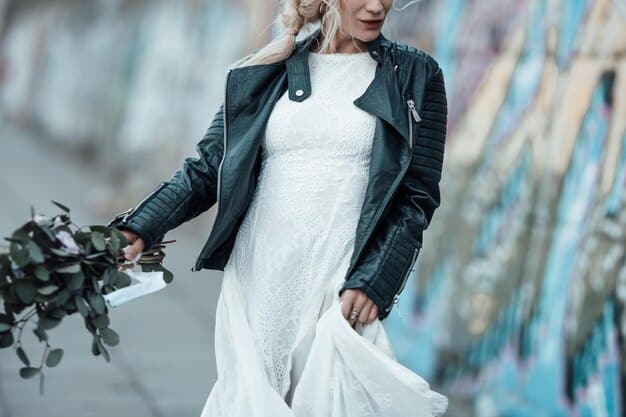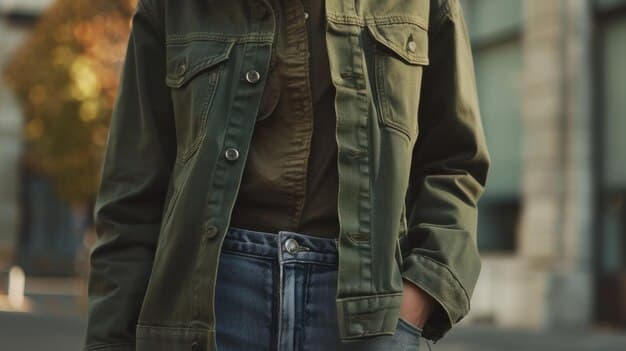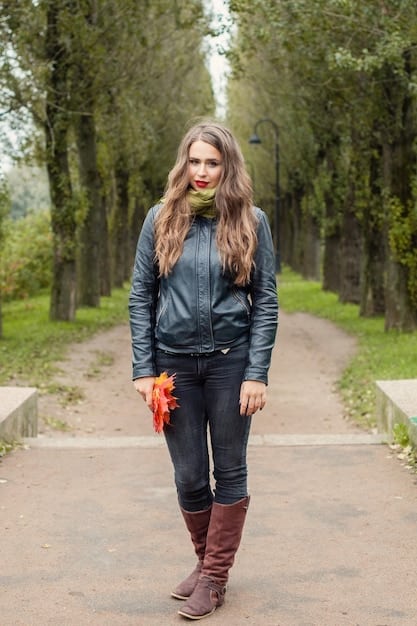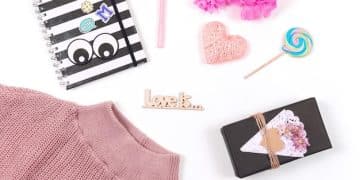Layering Outfits: 4 Techniques For Stylish Casual Looks

The Power of Layers: Elevate Your Casual Outfits with These 4 Layering Techniques by adding depth, texture, and personality to your everyday style. Discover how to master the art of layering with practical tips and examples to create versatile and fashionable looks.
Are you looking to take your casual outfits to the next level? The secret lies in mastering the power of layers: elevate your casual outfits with these 4 layering techniques. It’s not just about adding warmth; it’s about adding depth, texture, and personality to your style.
Understanding the Basics of Layering
Layering is a fashion technique that not only keeps you warm but also allows you to express your unique style. It involves combining different pieces of clothing to create a visually appealing and functional outfit.
Why Layering Matters
Layering isn’t just about throwing on extra clothes. It’s a strategic approach to building an outfit that can adapt to different temperatures and environments while showcasing your personal style.
Key Elements of Layering
To effectively layer, consider the fabrics, colors, and proportions of each piece. Start with a lightweight base layer, add mid-layers for warmth and texture, and finish with an outer layer for protection and style.
- Start with a thin base layer like a t-shirt or tank top.
- Add a mid-layer such as a cardigan or denim jacket for warmth.
- Choose an outer layer like a coat or trench coat for weather protection.
- Consider mixing different textures like cotton, denim, and wool.
Mastering these basics will help you create versatile and stylish layered outfits.
In conclusion, the foundation of successful layering lies in understanding its core principles and key elements. By thoughtfully combining fabrics, colors, and proportions, you can create outfits that are both functional and fashionable, allowing you to adapt to various weather conditions while showcasing your personal style.
Technique 1: The Classic Trio – T-Shirt, Jacket, and Coat
One of the most versatile layering techniques involves combining a basic t-shirt, a stylish jacket, and a functional coat. This trio works well in various settings and can be easily adapted to different styles.
Choosing the Right T-Shirt
Opt for a neutral-colored t-shirt made from breathable fabric like cotton or linen. White, gray, or black t-shirts are excellent choices as they can easily complement different colors and styles.
Selecting a Stylish Jacket
A denim jacket, bomber jacket, or leather jacket can add a touch of personality to your outfit. Choose a jacket that fits well and complements your personal style. Consider the weight and material of the jacket based on the weather.
- Denim jackets for a casual and classic look.
- Bomber jackets for a sporty and modern vibe.
- Leather jackets for an edgy and stylish appearance.

Proper selection of each garment is critical to achieving the desired aesthetic and functionality of the layered ensemble.
Combining a basic t-shirt, a stylish jacket, and a functional coat is a timeless way to achieve a well-layered outfit. The key is to ensure that each piece complements the others in terms of color, fit, and style, resulting in a versatile ensemble suitable for various occasions.
Technique 2: Embrace the Cardigan Layer
Cardigans are excellent layering pieces that can add warmth, texture, and a touch of sophistication to your casual outfits. They come in various styles, from lightweight knits to chunky wool, making them suitable for different seasons.
Lightweight Cardigans for Spring and Summer
Opt for lightweight cardigans made from cotton, linen, or viscose. These materials are breathable and comfortable, making them ideal for warmer weather. Choose cardigans in pastel colors or floral prints to add a fresh and feminine touch to your outfits.
Chunky Cardigans for Fall and Winter
For colder months, chunky cardigans made from wool, cashmere, or acrylic blends are excellent choices. These materials provide warmth and insulation, keeping you cozy and comfortable. Opt for cardigans in neutral colors like gray, beige, or navy for a versatile look.
- Pair a lightweight cardigan with a tank top and jeans for a casual summer look.
- Layer a chunky cardigan over a turtleneck sweater and trousers for a cozy winter outfit.
- Add a belt to cinch the waist and create a more defined silhouette.
Experimenting with different styles of cardigans will allow you to create unique and stylish layered outfits.
In conclusion, the cardigan layer offers a versatile solution for adding warmth, texture, and sophistication to casual outfits. Whether opting for lightweight cardigans in spring and summer or chunky knits in fall and winter, the key lies in selecting materials, colors, and styles that complement the overall aesthetic of the ensemble, resulting in a comfortable and stylish look suitable for any occasion.
Technique 3: The Vest and Shirt Combo
Combining a vest with a shirt is a fantastic way to add visual interest and depth to your casual outfits. This technique works particularly well for creating a smart-casual look that’s both stylish and comfortable.
Types of Vests to Consider
There are various types of vests to choose from, including quilted vests, denim vests, and knitted vests. Each type offers a different texture and style, allowing you to customize your outfit based on your preferences.
Pairing with Different Shirts
The key to a successful vest and shirt combo is to choose a shirt that complements the vest in terms of color, fabric, and style. A classic button-down shirt, a casual t-shirt, or a stylish blouse can all work well, depending on the occasion.
The possibilities are endless.
- Wear a quilted vest over a flannel shirt for a rugged and outdoorsy look.
- Pair a denim vest with a white t-shirt and jeans for a casual and laid-back vibe.
- Layer a knitted vest over a blouse and skirt for a more polished and sophisticated look.

By combining these elements thoughtfully, you can create outfits that are both stylish and comfortable.
Combining a vest with a shirt is a versatile technique for elevating casual outfits with depth and visual interest. By carefully selecting the type of vest and pairing it with a complementary shirt, individuals can craft smart-casual looks that reflect their personal style while ensuring both comfort and sophistication.
Technique 4: Accessorizing Your Layers
Accessories play a crucial role in completing any layered outfit. From scarves and hats to belts and jewelry, the right accessories can enhance your style and add personality to your look.
Scarves and Hats for Added Warmth and Style
Scarves and hats are not only practical for keeping you warm but also stylish accessories that can elevate your outfit. Choose scarves in different colors, patterns, and textures to add visual interest to your layered look. Hats can also add a touch of personality and flair.
Belts and Jewelry for Defining Your Silhouette
Belts and jewelry can help define your silhouette and add a touch of sophistication to your layered outfit. Cinching your waist with a belt can create a more flattering shape, while wearing statement jewelry can add a personal touch to your look.
- Add a colorful scarf to your layered outfit for a pop of color.
- Wear a wide-brimmed hat to protect yourself from the sun and add a stylish touch.
- Cinch your waist with a belt to create a more defined silhouette.
By carefully selecting and incorporating accessories, you can elevate your layered outfits from simple to stunning.
In conclusion, accessorizing layered outfits is essential for adding warmth, style, and personality. Whether incorporating scarves and hats for added warmth and visual interest, or utilizing belts and jewelry to define silhouettes and highlight personal style, the right accessories can elevate a layered ensemble, transforming it from basic to breathtaking.
Mixing Textures and Patterns
Experimenting with different textures and patterns is a great way to make your layered outfits stand out. Combining smooth and rough textures, as well as different patterns, can add depth and visual interest to your look.
Combining Smooth and Rough Textures
Pairing smooth textures like silk or satin with rough textures like wool or denim can create a visually appealing contrast. This technique adds depth and dimension to your outfit, making it more interesting and stylish.
Experimenting with Different Patterns
Mixing different patterns can be tricky, but when done right, it can create a bold and fashionable statement. Choose patterns that complement each other in terms of color and scale. For example, you can pair a striped shirt with a floral scarf or a polka dot blouse with a plaid blazer.
- Combine a silk blouse with a wool blazer for a sophisticated and stylish look.
- Pair a denim jacket with a cotton t-shirt for a casual and comfortable outfit.
- Mix a striped shirt with a floral scarf for a fun and playful vibe.
Mastering the art of mixing textures and patterns will allow you to create unique and eye-catching layered outfits.
In conclusion, combining textures and patterns represents a creative avenue for enhancing the visual appeal of layered outfits. Whether pairing smooth textures with rough textures or experimenting with complementary patterns, these techniques add depth, dimension, and a touch of boldness to a layered ensemble, resulting in a unique and eye-catching look.
Seasonal Layering Tips
Layering isn’t just for cold weather. You can adapt your layering techniques to suit different seasons, ensuring you stay comfortable and stylish year-round. Each season requires different garment and fabric choices.
Spring Layering
In spring, opt for lightweight layers that can be easily added or removed as the temperature fluctuates. A light jacket, a cardigan, or a scarf can provide just the right amount of warmth without making you feel overheated. Choose breathable fabrics like cotton, linen, or silk.
Summer Layering
Even in summer, layering can be useful, especially for evenings or air-conditioned environments. A lightweight shawl, a denim jacket, or a linen shirt can provide a bit of extra coverage without feeling too heavy. Choose light-colored fabrics to reflect the sun and keep you cool.
- Layer a lightweight jacket over a dress for a spring wedding.
- Wear a denim jacket over a tank top and shorts for a casual summer look.
- Add a colorful scarf to your outfit for a pop of color in any season.
Adapting your layering techniques to the season will ensure you stay comfortable and stylish no matter the weather.
In conclusion, seasonal layering involves adapting techniques to suit varying weather conditions throughout the year. Whether opting for lightweight layers in spring and summer or thicker garments in fall and winter, tailoring layering to the season ensures both comfort and style, allowing individuals to stay fashionable year-round.
| Key Element | Brief Description |
|---|---|
| 👕 Base Layer | Thin, breathable fabric like cotton or linen. |
| 🧥 Mid-Layer | Cardigan, denim jacket, or vest for warmth. |
| 🧣 Accessories | Scarves, hats, belts to add style. |
| 🌈 Textures & Patterns | Mix smooth/rough textures and complementary patterns for visual interest. |
FAQ
The main purpose is to add depth and style to an outfit while providing warmth and adaptability to changing temperatures. It’s also a way to express personal style.
Breathable fabrics like cotton, linen, or merino wool are excellent choices for base layers. They help wick away moisture and keep you comfortable throughout the day.
Yes, layering can work in warm weather. Use lightweight, breathable fabrics like linen or cotton. A light shirt over a tank top can provide sun protection and style.
Choose thinner fabrics for your base and mid-layers and avoid oversized or bulky outer layers. Ensure each piece fits well and complements your body shape.
Scarves, hats, belts, and jewelry can all enhance a layered outfit. Choose accessories that complement the colors, textures, and style of your clothing for a cohesive look.
Conclusion
Mastering the art of layering can transform your casual outfits into stylish and versatile looks. By following these four techniques and experimenting with different combinations, you can create outfits that reflect your unique style while staying comfortable and prepared for any weather.





